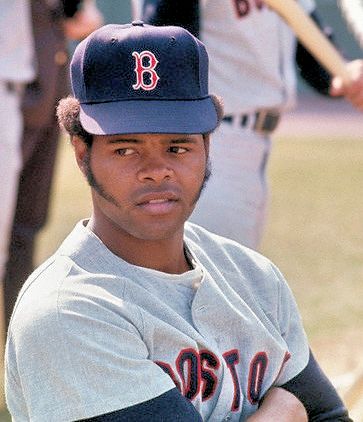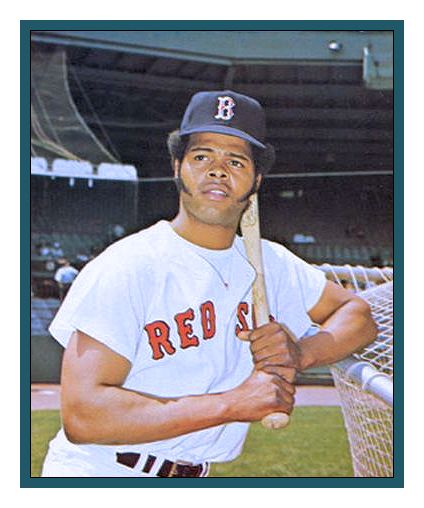|
“FENWAY'S BEST PLAYERS”  |
|||||||
Reggie Smith was from Los Angeles and grew up in South Central LA. He was only 15 when he was recruited to play only on Sundays for the Chet Brewer Pirates, the mission of a man who had been one of the Negro Leagues' greatest pitchers, Chet Brewer, who dedicated his post-playing career to working with children. Reggie went on to play sports at Centennial High School, where he was an All-California baseball pick at shortstop and won the same honors as a football player. After high school, he was signed as a free agent by the Minnesota Twins in June 1963. Reggie started with Wyetheville in the Appalachian League. He was unprotected in the draft, and was snared by the Red Sox. He ascended the ladder of the Red Sox farm clubs, playing for Waterloo (Midwest) and Reading (Eastern) in 1964, and Pittsfield (Eastern) in 1965. The following year he arrived in Toronto, the team's top farm club, where he played for Dick Williams on a championship team. Reggie led the league in batting average with a .320 BA. Reggie was a late season call-up to the big club in 1966 and in Yankee Stadium, he got the first three hits of his career against Fritz Peterson. The Red Sox finished ninth, but Reggie had secured a place in the team's youth movement. When Dick Williams inherited the manager position, he planned to install Reggie in center field, but the team had also brought in Toronto's Mike Andrews to play second base. Andrews, however, injured his back and Reggie started the season by returning to play second base for the team's first six games. Through mid-May, Reggie managed only a .180 average with two homers, as the team struggled, too. But he came on for the rest of the season, batting .258 with 13 homers while the team was playing 79-55 baseball. In August, Reggie crushed a homer from each side of the plate to lead his team to a 12-2 pummeling of the California Angels. He hit for power in the World Series, slugging .542 with a pair of homers in his 26 plate appearances. In 1968, he led the league with 37 doubles and earned a Gold Glove. The following season he hit .309 and also had one of the best defensive seasons of his career. In the Sox home opener in 1969, Reggie slammed a double, a triple, and a homer, while making a perfect peg that cut down a Yankee baserunner. In 1970, he picked up his career-high of 109 runs, and gunned out runners rapid-fire, notching his rifle with 15 assists. In 1971, he launched 30 home runs, his best season total to date. The Red Sox were a cliquish team, but not by perceived ethnicity. Reggie's closest friend was Yaz, and race relations in the clubhouse weren't bad, but Reggie hadn't been prepared for the intensity of the hate from the Boston fans. He used to receive hate mail that started with a racist epithet and then got worse. Playing in the outfield, he had to wear a batting helmet to protect himself from hard objects being thrown by his own team’s fans. He also thought there was a double standard in the way black and white players were treated by Sox management and by the Boston media. When he was a rookie, he was one of the very first Black players the team had brought up with star potential. Above Dick Williams and the team's GM Dick O'Connell, the front office and ownership of the organization was notoriously prejudiced. In 1973, there was a fight between Bill Lee and Reggie Smith in the Sox dugout. Reggie wanted Lee to take revenge on the Brewers for breaking Doug Griffin's arm, when he had been thrown at and hit by a pitch. But when Lee nailed Ellie Rodgriguez to hit, Reggie thought it was racially motivated. Words were exchanged, Reggie landed several punches to Lee's head and threw him to the ground. In August, Reggie walked off the field in the second inning of a game against the Angels. He showered and dressed and left without permission. He claimed his knees prevented him from playing. By the end of the month he was demanding to be traded, tired of the racism he faced in Boston. And so, Reggie was traded along with Ken Tatum from the Red Sox to the St. Louis Cardinals for Bernie Carbo and Rick Wise in October, 1973 Reggie Smith had an All-Star caliber major league He batted with (314 HRs) power and average (.287 BA) from both sides of the plate, was a fine center fielder, had superior base-running speed, and had a legendary throwing arm that may have been the best of his era. Defensively, he threw the ball so hard he could throw about two feet off the ground and the ball would rise up. From dead center field, he could easily throw a guy out at the plate. He was a "five-tool player "who played in four World Series, and in 81 plate appearances, pounded the ball for a .521 slugging percentage with six home runs. Being one of the outstanding young players in baseball, he had spent much of his career being compared to Mickey Mantle. He had the talent but was very temperamental and had he channeled it toward baseball, he might have been a Hall of Famer.
|
|||||||

